iPhone 7 and 7 Plus review: Apple (mostly) plays it safe
Except for, you know, the no-headphone-jack thing.
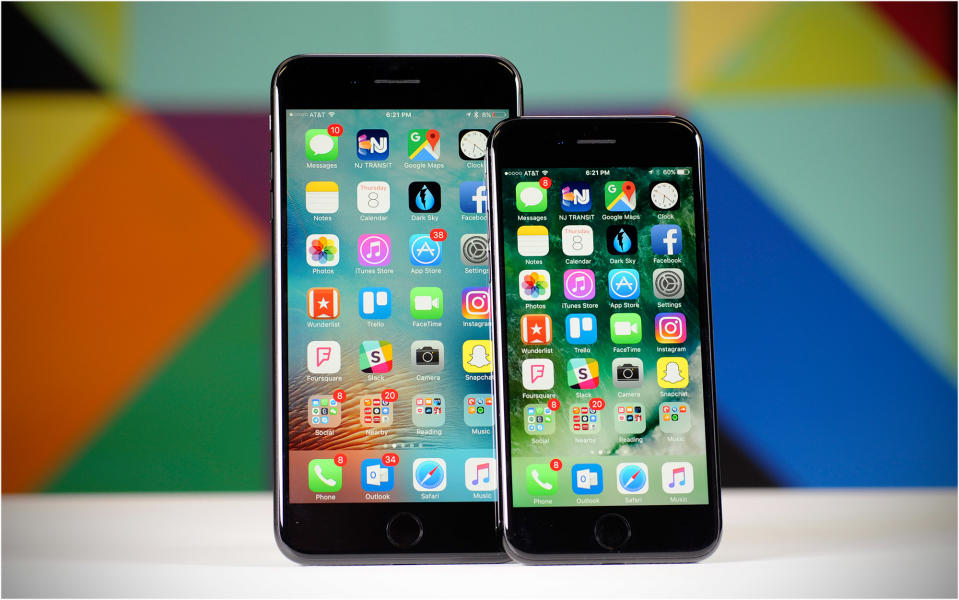
Tick-tock. Tick-tock. That clockwork rhythm has more or less defined Apple's iPhone road map since the days of the 3GS. One year we'd get a new iPhone with a new look and loads of features to agonize over and opine about. Then, the following year, we'd get the same general design with a faster chipset and a few new tricks. The rhythm was almost comforting in its regularity, which made Apple's unveiling of the new iPhone 7 and 7 Plus such an anomaly. It's easy to look at these devices as another year's worth of modest updates crammed into a familiar body, but trust me: It's a little more complicated than that. What Apple ultimately did was create two world-class smartphones that skew more toward "safe" than "state of the art". The big question here is whether a bunch of relatively unexciting changes add up to greatness.
Hardware
You don't need me to tell you that this year's iPhones look an awful lot like last year's. Like it or not, Apple believed there was still room to improve the phone design we've been using for two years, so it focused on that instead of cooking up a brand-new aesthetic. It's tempting to say Apple's current design philosophy boils down to "if it ain't broke, don't fix it," but that's not really true either: The company actually fixed a lot this year.
Some changes are subtler than others. The 7 and 7 Plus's antenna bands swoop around the phones' curves instead of cutting across their backs. The iPhone's 12-megapixel camera (or cameras, in the case of the 7 Plus) is surrounded by an aluminum hump, rather than just jutting out like in the old days. Apple finally made 32GB the new storage baseline and gave the 7 and 7 Plus a seriously spacious 256GB option. Both models are the exact same size as the models that preceded them, but the 7 and 7 Plus have each shed a couple of grams here and there. The loss of a few paper clips' worth of weight isn't nothing, though, especially when we're talking about devices that we hardly ever put down.
From there, the list of changes starts to look more substantial. If you're lucky, you'll never need to know that the 7 and 7 Plus meet IP67 water-resistance standards. In other words, they're built to withstand dust ingress and, more important, submersion in up to a meter of water for 30 minutes. Apple's rivals have made big strides in making their smartphones more life-proof, so all I can really say is: It's. About. Time. Finally, we get iPhones that'll survive when you drop them in puddles, get caught in the rain or intentionally dunk them in beer. (Note: liquid damage still isn't covered by Apple's warranty.) Catching up to the competition has never been so welcome, or so tasty.

Meanwhile, the all-too-familiar home button isn't a physical button anymore. It's a solid-state affair that makes the phone taptically throb when you push it. This wound up being way more divisive a tweak than I expected; when I showed it off to colleagues, just about all of them recoiled at first press. As a longtime iPhone user, I can't quite explain how off the sensation felt at first, but it only took about a day for me to get over it. Now it's a little weird to press an older iPhone's home button and not get the little bzzt of feedback from the Taptic Engine; but I digress.
The phones come in new colors too: a matte black and "jet black." The former looks exactly what you'd expect a black iPhone to look like, though the dark finish does a good job obscuring those antenna bands. Jet black, meanwhile, is at once lovely and a bit of a bummer. When I say lovely, I really mean it: The moment I touched one, I couldn't believe it was made of the same 7000 series aluminum as the others. In fact, it doesn't feel like metal at all, thanks to Apple's lengthy anodization and polishing process. Jet black iPhone bodies feel just as glossy and slick to the touch as their glass screens, and that unity makes them feel like seamless, cohesive wholes. The entire thing is seriously impressive, even if it feels sort of plasticky.
Then the scratches and smudges appear. I'm not a case person, but I take good care of my things and exercised what felt like a more than reasonable level of caution carrying these new phones around. It didn't even take 24 hours for the first batch of scratches to appear on my jet black iPhone 7's back, which was either the result of placing it on a bar's granite countertop or repeatedly shoving it into my empty jeans pocket. Those little nicks have only multiplied, which could be an understandable deal-breaker for some of you.
And now we've come to the elephant in the room. Neither the iPhone 7 nor the iPhone 7 Plus has a traditional 3.5mm headphone jack. To hear Apple tell the tale, getting rid of that decades-old standard wasn't just a practical move to make waterproofing and increased battery life possible -- it was also an act of "courage." Here's a bit of unsolicited advice for Apple: I get that changing the world is sort of your thing, but maybe go easy on the hubris next time. Anyway. I'll dig into audio quality in just a moment, but suffice to say that the toughest part of not having a headphone jack is trying to break all my old listening habits. I can't tell you the number of times I tried to plug a regular pair of earbuds into these phones before -- d'oh! -- remembering that doesn't work and then having to root around for the included Lightning-to-3.5mm adapter.
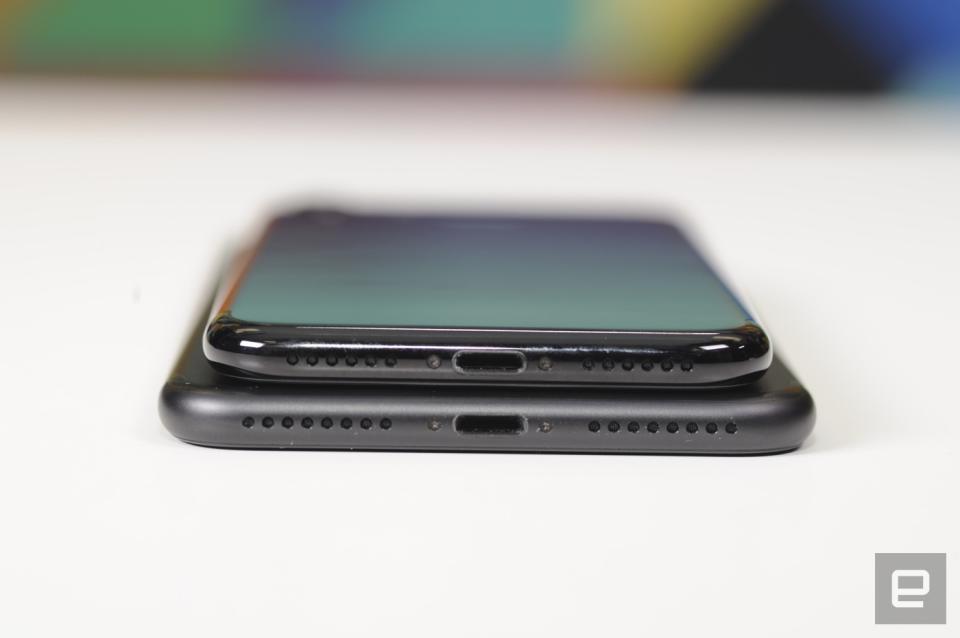
This also means you can forget about charging your phone while listening to music at the same time -- unless you have wireless headphones or are willing to buy a third-party adapter to split that Lightning port. (When asked if the company planned to release its own splitter, an Apple spokesperson said they had "nothing to announce.") The iPhone 7 and 7 Plus have better batteries than the models that came before them, so charging and listening honestly hasn't been a big issue, but still, no one would fault you for crying foul. Either way, Apple isn't the only company to have signed the headphone jack's death warrant. Motorola released two flagship phones this year that used their USB Type-C ports for audio, though it did so at least partially because it expected Apple to ditch that jack, too.
Display and sound
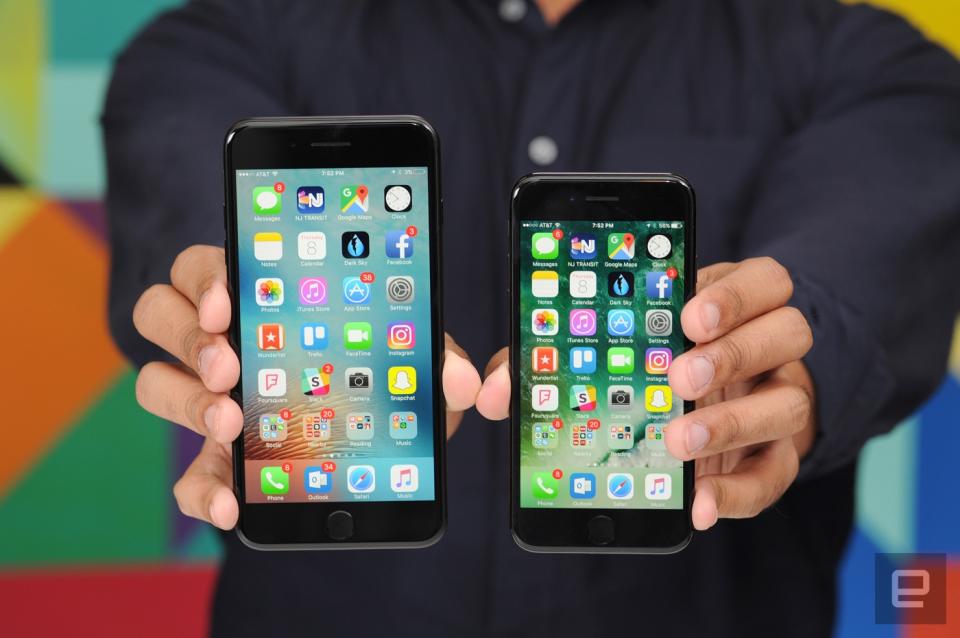
Once again, the smaller iPhone 7 has a 4.7-inch Retina HD screen, while the Plus has a 5.5-inch display. The resolution and pixel density are the same too, so you're not going to be seeing anything more crisply now than you did in 2015. Rather than chase other companies squeezing higher-res displays into their phones, Apple chose to focus on a more fundamental part of these screens: how they render color. The 7 and 7 Plus support the DCI-P3 wide color gamut, which -- long story short -- means they're capable of reproducing more colors than the standard sRGB color range. Put another way, they're able to display more vivid, nuanced images than the iPhones that came before them, thanks to a color space that's standard in the film industry.
So what does that mean for your day-to-day life? Well, it kind of depends on how good your eyes are. The difference between these displays and the ones we got last year aren't always obvious. Colors are often a touch brighter, and you can see subtle shades that help images feel more lifelike: Skies are bluer, sunsets are warmer and people's skin looks more lively. Then again, changes that seemed subtle to me were more pronounced to others, so maybe my eyes are a little dim.
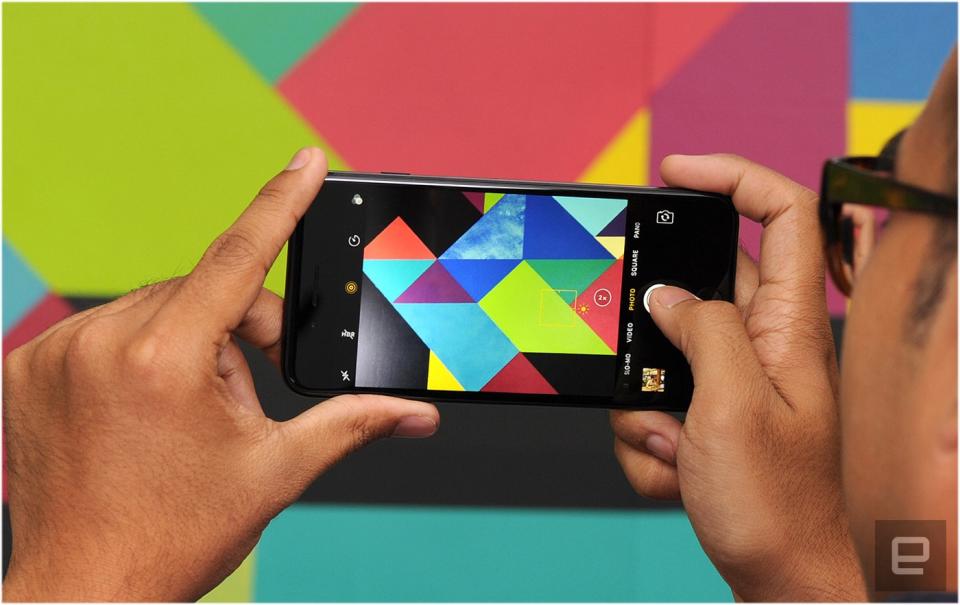
The screens in the iPhone 7 and 7 Plus are also notably brighter than on last year's models, and they've gained a new trick for when you're outdoors. Apple says it uses the 7 and 7 Plus's ambient light sensor to tell if you're inside; if not, the screen can get even brighter to compensate for sunlight. That's right: Not all maximum brightness levels are created equal. That being the case, I'm a little surprised Apple didn't bring the 9.7-inch iPad Pro's TrueTone color-temperature-tweaking system to the 7 and 7 Plus. My guess is they couldn't squeeze it into these phones' smaller bodies.
Here's another first: The 7 and 7 Plus are the first iPhones to feature stereo audio (another trick Android phone makers have dabbled with for ages). Why it took so long for Apple to try this eludes me; they're a huge addition to the iPhone formula. Movies, podcasts and speakerphone calls sound dramatically better now, though the stereo separation doesn't seem quite as pronounced as on devices like the old HTC Ones. That's thanks to Apple's speaker setup -- rather than stick two speakers right on these iPhones' faces, sound springs forth from the main earpiece and the speaker on the bottom-right edge. I'll take it.
If you're still bristling about the whole needing-an-adapter-for-your-headphones thing, well, at least the sound quality doesn't suffer in the process. I used my go-to headphones (a pair of Samsung Level On PROs) to listen to the same music on the 6s and on an iPhone 7 with the Lightning adapter, and couldn't tell any difference at all. Ditto for a blind listen-off between the 6s and the 7 Plus: They sounded identical to me.
Camera

This is where things get really interesting. By now you know the iPhone 7 has a single 12-megapixel camera on its back, and guess what -- it's a damned good one. That's saying something, considering there's been no resolution boost since last year, and the pixels on that new sensor haven't gotten bigger either. And yet the photos they capture come out significantly better; there wasn't a big difference in how much detail was captured, but colors looked more vibrant and true to life than on the iPhone 6s Plus.
Surprised? You shouldn't be. The iPhone 7's camera captures more color data than previous ones (the better to view on that wide-color-gamut display), and the results are pretty great. In fact, I generally preferred shots taken with the iPhone 7 and 7 Plus to ones captured with a Galaxy S7 Edge. The latter captured a wider field of view and was sometimes better accurately rendering green landscapes, but the iPhone's leg up on colors meant their photos tended to look nicer (to me, anyway). Test shots taken with the iPhone 7 were also generally better exposed than similar shots taken with the 6s, which in my case usually meant fewer blown-out skies washing out my photos. But every smartphone camera does well when it's bright outside. What about when things get dim?
It's a toss-up. The inclusion of optical image stabilization across both versions of the iPhone 7 helps, as does the main camera's f/1.8 aperture. Props to Samsung: Photos taken with the S7 Edge did indeed look brighter, but the iPhone 7 and 7 Plus offered more natural colors. Before today I would've said the S7s and the Note 7s had the best all-around smartphone cameras, but now Apple is right there, neck and neck with the best of them. The iPhone 7's front-facing camera has also received a major upgrade. It's been bumped up to seven megapixels and inherited some of the architecture that made the rear cameras so formidable. Long story short, your selfies are going to look lovely. Oh, and videos look really nice too, since they exhibit the same accurate colors as stills. Go forth and vlog, you pioneer.
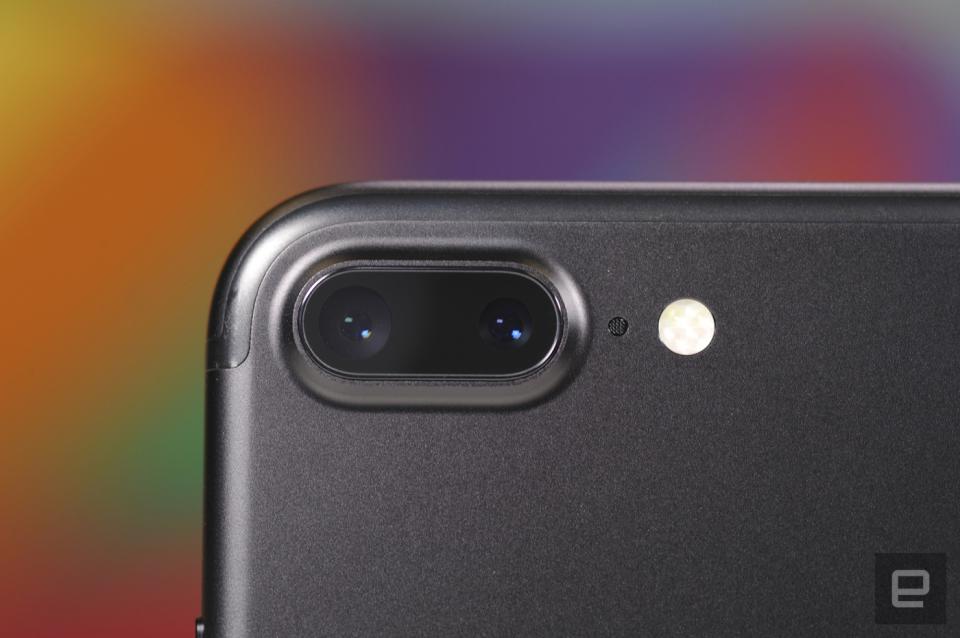
Then, of course, there's the iPhone 7 Plus's dual camera setup, which pairs a 12-megapixel wide-angle shooter with a 12-megapixel telephoto camera to give the Plus an actual zoom. Apple isn't the first to dabble in dual cameras, nor is it the first company to attempt this zooming configuration; LG tried it earlier this year with half-decent results. Apple's approach feels more elegant, though -- with a quick tap you can switch between 1x and 2x zoom modes, or you can drag a slider or pinch with two fingers for more precise control. By the way, you'll probably want to stay at 1x or 2x zoom (or somewhere in between). Apple added digital zoom up to 10x, and the closer you get to that ceiling, the noisier and more indistinct things get. That's not surprising, though.

This whole thing might sound like a gimmick, and it sort of feels like one for a few minutes. After that, the "what do I do with this?" factor falls away and the optical zoom just becomes a handy trick to have at your disposal. The photos turned out great too, though you might notice some differences in the colors and exposure if you take comparison shots with both of the iPhone 7 Plus's cameras. The secondary telephoto camera still shoots 12-megapixel photos, but it has a slightly wider f/2.8 aperture. Basically, it doesn't let as much light in, so the photos come out a little different. Avid photographers might take issue with these minute changes; everyone else need not worry. For now, this is the only trick the 7 Plus has that the smaller 7 doesn't, but that'll change soon. Apple's going to update it with a feature that lets you play with depth of field when you're shooting portraits, so you can get a little more bokeh going on.
Software

The iPhone 7 and 7 Plus might not seem like the most exciting hardware updates, but there's plenty to get excited about in iOS 10. Granted, very little of it will come as a surprise, since it's been available as a public beta for months now. Our full review is coming soon, and I've already detailed some of the new features, so I'll just recap the highlights here.
It took a while for me to get used to the revamped Photos app, but I sort of love it now. The app's original form was really basic: You could sift through your photos by "Moment" and poke around in albums, shared or otherwise. The iOS 10 version, meanwhile, uses machine learning to sort photos into themed "memories" based on where you've been and when you've done things. The best part: searching through all your photos by keyword, since iOS 10 uses AI to identify what's in your picture. As it turns out, I have 14 pictures with bibs in them despite not being a parent.

Apple's bright, bold new Music app was easier to jump right into, and I'm a fan now. The first time you launch the app, you're dropped right inside your music library (which is how it should be). All of the touch targets are bigger and easier to hit, even when I was glancing down at them mid-run. It's also satisfying to see 3D Touch finally get more use. I wrote in my iPhone 6s review that using that pressure-sensitive screen was something I eventually wanted to do all the time; too bad iOS 9's never tapped into its full potential. Not anymore. It feels like 3D Touch is connected more strongly to iOS 10's core; I've been using it to expand notifications, bring up contextual menus in Apple Music and glance at widgets for first-party apps like the dialer and Weather.
Apple is also making better use of the Taptic Engine this time around, so you'll feel it all over the place -- literally. The prominent examples are the ones you'd expect, like 3D-Touching notifications and using the home button, but you'll also feel a brief thud when you flick the Control Center open. Skimming your Apple Music collection for a specific song? Sliding your finger down the alphabet on the side of the screen feels like running your finger down a washboard, allowing you to more easily stop on a letter.
Oh, by the way, the process of forcing your 7 or 7 Plus to restart is totally different. Instead of holding down the power and home buttons like we have been for a decade, the new process requires you to hold down the power and volume down keys.

And now for some bad news: I still haven't been able to test some of iOS 10's headline features. Siri's intelligence is poised to get a big upgrade thanks to third-party apps, but I couldn't yet ask her to call me an Uber or send my friend $20 via Venmo. And while I'm also a little obsessed with sending these weird new iMessages, it's too bad that at time of writing, the iMessage app store was still virtually barren. I'll update this review as the store comes online and I get to play with more weird stuff.
Performance and battery life
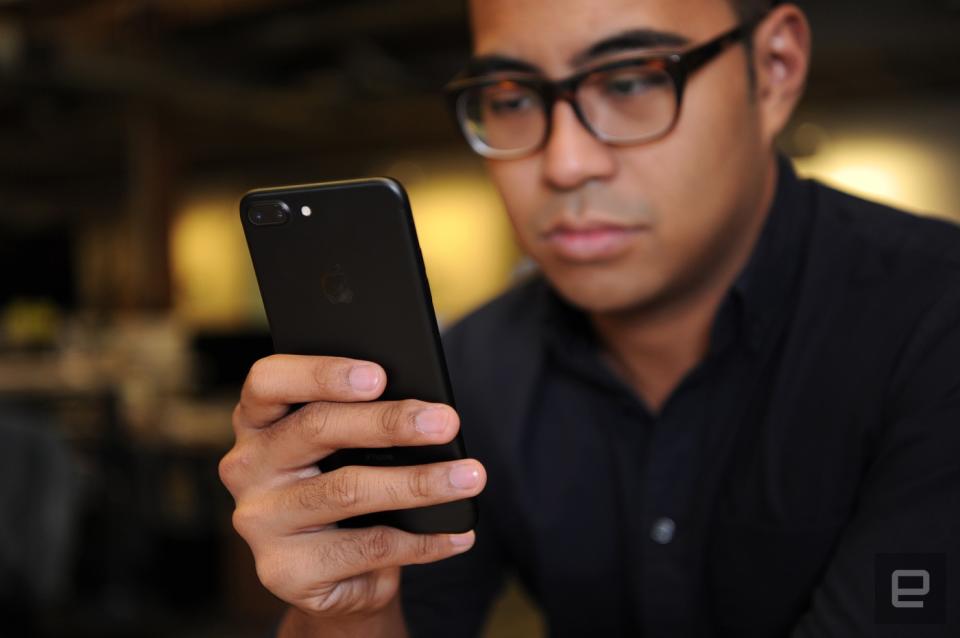
Another year, another high-powered A-series chip to play with. The iPhone 7 and 7 Plus both run the company's new A10 Fusion, a quad-core chipset that pairs two speedy CPU cores with two longer-lasting ones that use 20 percent of the power the others do. It's easily the fastest chip Apple has ever stuck in a mobile device, beating out even the 9.7-inch iPad Pro's A9X processor. More important, there's basically zero difference in performance between the 7 and 7 Plus, even though the smaller version has 2GB of RAM, versus 3GB on the Plus.
I restored the new iPhones from backups of our 6s and the differences were immediately clear. There's almost no delay from when you tap an app icon to when it launches, and popping in and out of apps was noticeably faster too. Both the 7 and 7 Plus were also able to handle graphically demanding games like Warhammer 40,000: Freeblade, Submerged and Mortal Kombat X without breaking a sweat.
In fairness, the 6s and 6s Plus played these nearly as well, but the 7 and 7 Plus's batteries don't get depleted as much in the process. Part of that is likely due to the 6s's battery deteriorating over time, but the A10 Fusion's GPU is also more power-efficient. Ultimately, what might be most telling is that when it came to day-to-day use, I stopped thinking about performance completely.
iPhone 7 | iPhone 7 Plus | iPhone 6s | iPhone 6s Plus | |
|---|---|---|---|---|
3DMark Unlimited IS | 37,663 | 37,784 | 24,601 | 27,542 |
Geekbench 3 (multi-core) | 5,544 | 5,660 | 4,427 | 4,289 |
Basemark OS II | 3,639 | 3,751 | 2,354 | 2,428 |
We can't talk performance without delving into the 7 and 7 Plus's batteries, and thankfully they're an improvement over last year. One of the few upsides to removing that headphone jack was that it freed up more space to make these batteries a little bigger -- 14 percent larger in the iPhone 7 and 5 percent in the 7 Plus. In our standard video rundown test (in which the phones are connected to WiFi with a video looping at 50 percent brightness), the 7 lasted for 12 hours and 18 minutes, or just about two hours longer than the 6s. The 7 Plus, meanwhile, looped Whiplash for 14 hours and 10 minutes, or about an hour and a half longer than the 6s Plus. That's also on par with Samsung's Galaxy Note 7. Not bad at all.
Eventually, though, I had to give up on bingeing on a raw jazz thriller and get some actual work done. These days, my usual routine involves lots of Slack messages, emails, Spotify playlists and marathon Hearthstone sessions. When put through that very specific kind of wringer, the iPhone 7 usually stuck around for a full workday and often survived until mid-morning the following day. The 7 Plus, meanwhile, frequently lasted through nearly two days of mixed use and downtime, a notable improvement over the 6s Plus. Obviously, your mileage will vary, but here's hoping that these upgraded batteries stay this good over time. (We'll see about that.)
The competition
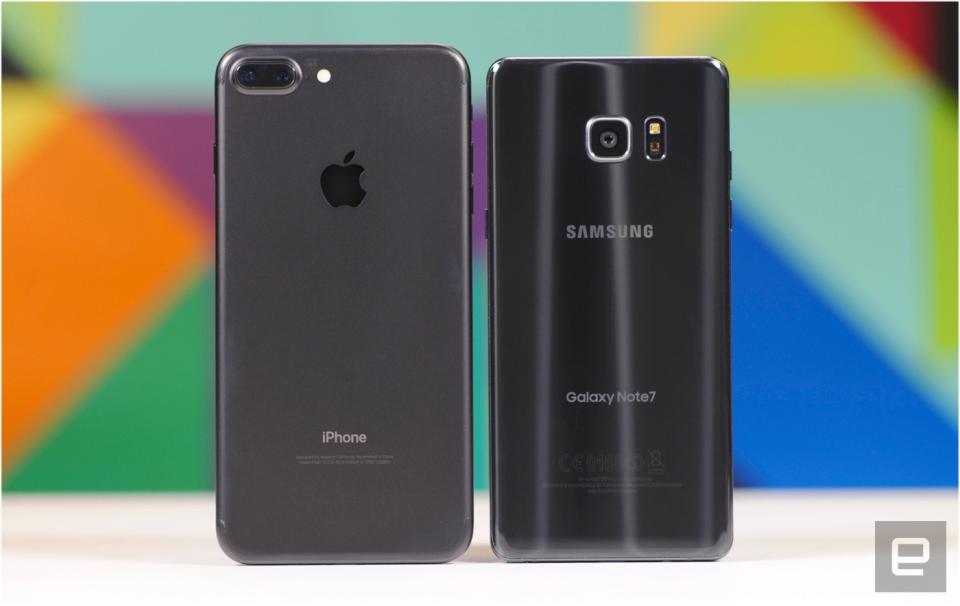
Under normal circumstances, the Galaxy Note 7 would be at the top of this list, but, well ... you know. While Samsung continues its global recall over exploding batteries, you should consider the Galaxy S7 and S7 Edge in the Note's place. They share the same Snapdragon 820 chip and 4GB of RAM, not to mention the same lovely 12-megapixel cameras that rival the sensor Apple used this year. If you're a screen snob, Samsung's displays might be more appealing, since they run at a higher resolution and also support a wider color gamut than the sRGB standard. Apple and Android fans often tussle over which platform is superior, but make no mistake: The newest iPhones and the newest Galaxies are all truly excellent smartphones.
Looking for impeccable build quality and equally good sound? Consider HTC's underrated 10. It's easily the most impressive phone the company has crafted in years, and with support for hi-res audio and a headphone jack, it's arguably a more versatile media machine. Speaking of HTC, it's rumored to be working on the two most anticipated Android devices of the moment. We're not entirely sure if they'll be called Nexus phones or Pixel phones or something else entirely -- either way, Google is said to be prepping for an October 4 unveiling. Codenamed "Sailfish" and "Marlin," both are expected to pack quad-core Qualcomm chipsets (either the Snapdragon 820 or 821) with 4GB of RAM and 12-megapixel main cameras.
The biggest difference is reportedly the size of their screens, with the smaller Sailfish sporting a 5-inch or 5.2-inch 1080p display, while the Marlin runs with a 5.5-inch Quad HD screen. If you don't care about smartphones as much as you care about getting the best phone, period, you might want to wait and see what Google has up its sleeve.
Wrap-up
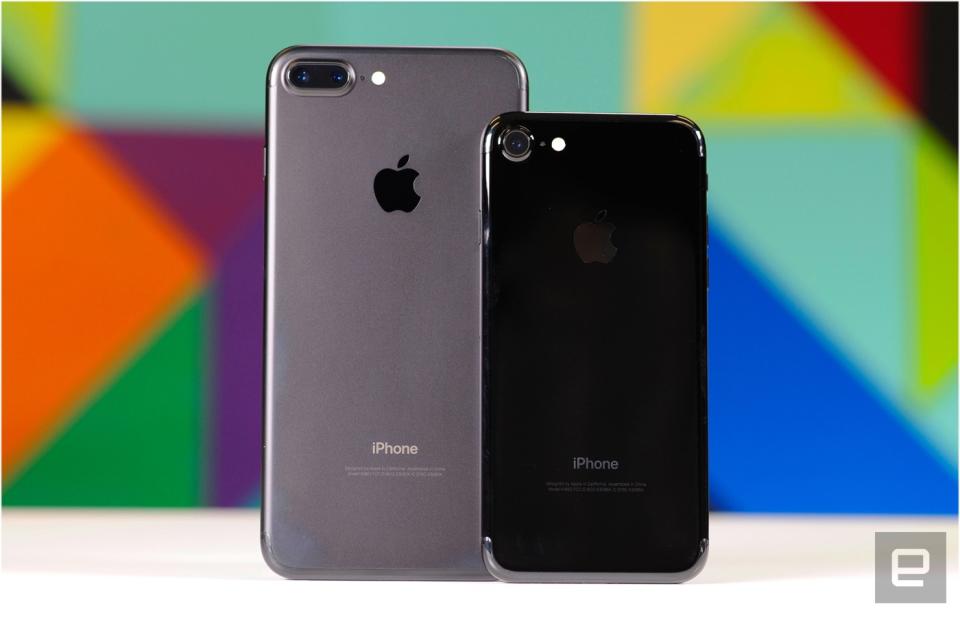
The iPhone 7 and 7 Plus are at once the most technically impressive smartphones Apple has ever made and the most divisive. After all, they're excellent because of Apple's renewed attention to the basics: the speed, the camera, the screen, the battery. None of these improvements on their own are terribly exciting, but together they make for a pair of phones that are more than the sum of their parts. Then again, where's the envelope-pushing? Where's the Apple that upended an industry? It's surely still there, locked behind closed doors that won't be opened again for another year. In the meantime, we're left to consider this year's work.
If you can get over the all-too-familiar design and the no-headphone-jack thing, then the iPhone 7 and 7 Plus are serious contenders for best smartphones, period. Note that I used the word "best," not "most innovative" -- neither of these devices is groundbreaking. We've seen many of these features (or features like them) pop up in rival phones already. That headphone jack thing aside, most of the choices made in the iPhone 7 and 7 Plus feel like safe ones. There's nothing wrong with that, but no matter how good the iPhone 7 and 7 Plus are (answer: very, very good), Apple already has us all wondering what next year's iPhone is going to be like.
All product photography by Will Lipman.









































































